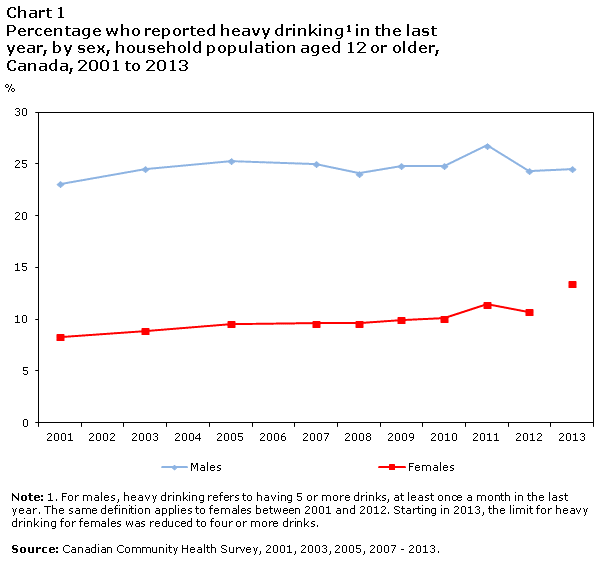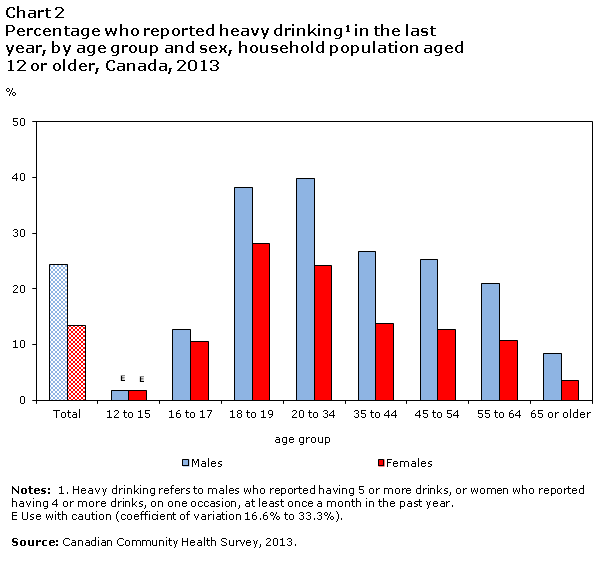Heavy drinking, 2013
Archived Content
Information identified as archived is provided for reference, research or recordkeeping purposes. It is not subject to the Government of Canada Web Standards and has not been altered or updated since it was archived. Please "contact us" to request a format other than those available.

Excessive alcohol consumption can have serious health and social consequences, especially when combined with other behaviours such as driving while intoxicated. For males, heavy drinking refers to having consumed five or more drinks, per occasion, at least once a month during the past year. The same definition applies to females between 2001 and 2012. Starting in 2013, the limit for heavy drinking for females was reduced to four or more drinks.Note 1
In 2013, 18.9% (5.5 million) of Canadians aged 12 and over reported alcohol consumption that classified them as heavy drinkers.
Heavy drinking was reported among 24.5% of males and 13.4% of females in 2013. For males this rate was about the same as 2012 (24.3%), but a significant decrease from 26.8% in 2011. As a result of the change in definition of heavy drinking for females, 2013 estimates are not directly comparable to previous years. The increased proportion of female heavy drinkers from 10.7% in 2012 to 13.4% in 2013 is partly due to the new definition in 2013 (Chart 1).

Typically, a higher proportion of males report heavy drinking than females. In 2013, this still holds true, even with the limit for females being lowered to four or more drinks. Males were more likely to report heavy drinking than females for all ages, except between 12 and 17, where there was no significant difference between the sexes.
The highest rates of heavy drinking for both sexes were among those aged 18 to 34. In the 18 to 19 age group, 38.3% of males and 28.2% of females reported heavy drinking. In the 20 to 34 age group, the rates were 39.8% for males and 24.2% for females (Chart 2).

The proportion of residents who reported heavy drinking was lower than the national average (18.9%) in:
- Ontario (17.1%)
- British Columbia (17.4%)
The proportion of residents who reported heavy drinking was higher than the national average in:
- Newfoundland and Labrador (24.5%)
- New Brunswick (25.1%)
- Quebec (20.8%)
- Yukon (32.4%)
- Northwest Territories (33.0%)
Residents of the other provinces and NunavutNote 2 reported rates that were about the same as the national average.
End notes
References
Hindmarch I, Bhatti J, Starmer G, Mascord D, Kerr J, Sherwood N. 1992. The effects of alcohol on the cognitive function of males and females and on skills relating to car driving. Human Psychopharmacology: Clinical & Experimental [serial online]. Vol.7, No. 2:105. March.
Hotton, Tina and Dave Haans. 2004. “Alcohol and drug use in early adolescence.” Health Reports. Vol. 15, no. 3. May. Statistics Canada Catalogue no. 82-003. p. 9–19. http://www.statcan.gc.ca/studies-etudes/82-003/archive/2004/6846-eng.pdf (accessed May 10, 2010).
Pérez, Claudio. 2005. “Passengers of intoxicated drivers.” Health Reports. Vol. 16, no. 2. March. Statistics Canada Catalogue no. 82-003. p. 35–37. http://www.statcan.gc.ca/studies-etudes/82-003/archive/2005/7788-eng.pdf (accessed May 10, 2010).
Tjepkema, Michael. 2004. “Alcohol and illicit drug dependence.” Health Reports. Vol. 15 (Supplement). Statistics Canada Catalogue no. 82-003. p. 9–19. http://www.statcan.gc.ca/pub/82-003-s/2004000/pdf/7447-eng.pdf (accessed May 10, 2010).
Wilkins, Kathryn. 2002. “Moderate alcohol consumption and heart disease.” Health Reports. Vol. 14, no. 1. October. Statistics Canada Catalogue no. 82-003. p. 9–24. http://www.statcan.gc.ca/studies-etudes/82-003/archive/2002/6342-eng.pdf (accessed May 10, 2010).
Data
Additional data from the Canadian Community Health Survey are available from CANSIM table 105–0501.
- Date modified:
